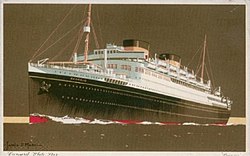Georgic (ship, 1932)
|
||||||||||||||||
|
||||||||||||||||
|
||||||||||||||||
|
||||||||||||||||
The Georgic (II) was a ship of the White Star Line and later the Cunard Line .
It was made by Harland & Wolff Ltd. built in Belfast , commissioned in 1932 and delivered to Cunard by the White Star in 1950. In 1956 it was finally decommissioned and demolished.
Regular scheduled services
Sister ship
- Britannic (built 1930)
Ship life
Beginning and appearance
The second motor ship after the Britannic for the Liverpool - New York line of the White Star Line was the Georgic . Like her sister ship and porch, she was built at the Harland & Wolff shipyard in Belfast, launched on November 12, 1931 and, after completion in June of the following year, sent on her maiden voyage on the 25th of that month .
Basically the Georgic and Britannic from 1932 were sister ships, but they differed in details. For example, the bridge front wall of the Georgic was slightly rounded, that of the Britannic was flat. The interior of the Georgic was contemporary, while the extension of the Britannic, built a little earlier , could be described as conservative. The forward funnel was a dummy on both ships and housed the radio room and the smoking room of the engine personnel.
The passenger accommodations were divided into three classes, cabin, tourist and third class.
Until World War II
Until the outbreak of World War II, the two ships shuttled back and forth on the North Atlantic , with interruptions in the winter months when they went on cruises .
In 1933 the Georgic jumped in for a few voyages from Southampton for the Olympic, which was in the shipyard .
In 1935, both ships moved to London as the port of departure for the New York voyages.
Second World War
The Georgic remained after the war for a few tours on the North Atlantic, but was drafted in March 1940 for naval service and as a troop carrier prepared. The soldier shipments took her to Norway , Saint-Nazaire and Brest , where she was exposed to a number of air raids . Further troop transports to Iceland , across the Atlantic and to the Middle East followed. Among other things, she drove in the WS 3F convoy , together with other troop transports to Aden .
The Georgic had arrived in the port of Tewfik with soldiers on July 7, 1941 . They were just about to load for the journey home when German bombers flew an air raid on the port in the morning hours of July 14th. Serious damage was caused to the port facilities, and the Georgic, as the largest ship in the port, was of particular interest to the attackers. A bomb exploded near the ship and tore a leak in the side of the ship. Another hit the stern and penetrated five decks before exploding. Fire broke out immediately and the ammunition rooms below deck went up. Soon the ship was ablaze. The captain had managed to maneuver his ship onto the beach so that it would not sink in the harbor, with the engine personnel bravely staying below in the engine room and performing the maneuvers. The passengers fell overboard and the ship burned for two days.
After a temporary repair and pumping out the water, the Georgic was towed free and transferred to Port Sudan . She lay there for several weeks, and the time was used for further provisional repairs, as the ship was about to travel 2,775 nautical miles to Karachi .
Since the engines were unclear, she was towed there by the two freighters Clan Campbell and City of Sydney in 26 days. After arriving on April 1, 1942, the men had a lot of work to do. Within eight months, they made the ship reasonably fit to sail, leaving much to the improvisational skills of the workers. The Georgic then drove to Bombay under its own power to dock and for further hull repairs. On January 20, 1943, the ship started an adventurous journey home to Great Britain without an escort .
Once there, she ran to the shipyard in Belfast to be converted into a permanent troop transport. The upper decks, which had not yet been restored after the fire, were completely renovated, the engines thoroughly overhauled, and in December 1944 the ship looked almost like a new building. The front chimney had been removed, so had the rear mast, and the front mast had become quite a bit shorter. A small signal mast had been erected behind the bridge .
The ship, painted gray from top to bottom, now belonged to the British Ministry of Transport, the management (ship-keeping) was in the hands of the Cunard-White-Star-Line.
After the Second World War
The naval service lasted until 1948 when the ship was redesigned again, this time as an emigrant ship .
The Georgic has now been sent from Liverpool to Australia along with other ships . Nonetheless, she occasionally made transatlantic trips for Cunard from Liverpool to New York in 1950, and between 1951 and 1954 from Southampton.
During this time she also carried out a troop transport, namely in 1955 to Japan . In November 1955 the ship was decommissioned. It arrived on February 1, 1956 at the Metal Industries scrapping yard in Faslane .
